|
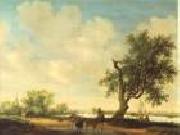 |
RUYSDAEL, Salomon van
|
|
Dutch Baroque Era Painter, ca.1600-1670.
Dutch painter. He is best known for his atmospheric, almost monochromatic, river scenes, painted in the 1630s during the 'tonal phase' of Dutch art. His work in this genre is very close in style to that of Jan van Goyen, and their paintings have often been confused. |
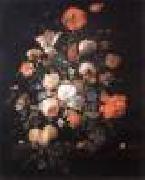 |
RUYSCH, Rachel
|
|
Dutch Baroque Era Painter, 1664-1750
Dutch painter. She specialized in still-lifes of flowers and fruits and still-lifes in outdoor settings, the large majority signed, with dated examples from 1681 to 1747 providing a sound chronology. She is widely regarded as the most gifted woman in the history of the subject and among the greatest exponents of either sex. Ruysch came from a distinguished and wealthy background. Her father, Frederik Ruysch (1638-1731), was an eminent professor of anatomy and botany, who published his fine collection of natural curiosities. He was also a gifted amateur painter. Her mother was the daughter of the architect Pieter Post. At the age of 15 Ruysch became a pupil of Willem van Aelst until his death in 1683. In 1693 she married the portrait painter Juriaen Pool (1665-1745), a happy union that produced ten children. In 1709 the couple moved to The Hague, where both artists joined the Guild of St Luke. From 1708 to 1713 they were both court painters to the Elector Palatine, John William, at D?sseldorf, for whom they continued to work until his death in 1716. In that year they returned to Amsterdam, where Ruysch continued working until at least the age of 83. |
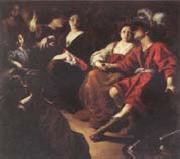 |
Rutilio Manetti
|
|
Italian Baroque Era Painter ,
1571 - 1639
was an Italian painter of late-Mannerism or proto-Baroque, active mainly in Siena. He was influenced and/or taught by the local artists Francesco Vanni and Ventura Salimbeni. He is known to have collaborated with Raffaele Vanni, the son of Francesco. He is known for the following works in Siena or nearby towns: Story of St Catherine and Pope Gregory (1597; Palazzo Pubblico), Baptism of Christ (1600; San Giovannino in Pantaneto); a fresco cycle of the Story of St Roch (1605-1610; San Rocco alla Lupa), Pope Alexander I freed from prison by an Angel from San Giovanni Battista in Sant'Ansano in Greti; a Temptation of Saint Anthony (1620, Sant'Agostino), a Death of Blessed Antonino Patrizi (Monticiano, 1616), a Blessed Domenico dal Pozzo at the table now in Certosa of Florence, a Birth of Virgin (1625, Church of Santa Maria dei Servi), and a painting (1628, Church of San Domenico). He painted a remarkable Allegory of the four seasons and a Parable of the blind men, now in private collections. He also contributed to the Casino Mediceo His style moved from one derived from Barocci to a more Caravaggesque manner after the first decade of the 1600s. |
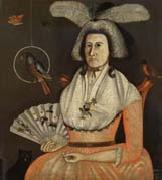 |
Rufus Hathaway
|
|
American country painter , 1770-1822
American painter and physician. He may have been apprenticed to ship-carvers and decorators, but he was not trained in fine art. His earliest known portrait, Lady with her Pets (1790; New York, Met.), demonstrates his unsophisticated, decorative style. Between 1790 and 1796 he seems to have worked as an itinerant artist; only portraits of relatives and friends survive. During his life he painted at least 25 portraits as well as miniatures, views and decorative overmantels. He also painted a genre subject, the Welch Curate, c. 1800 |
 |
rudolph von alt
|
|
Rudolf Ritter von Alt (28 August 1812 in Vienna ?C 12 March 1905 in Vienna) was an Austrian landscape and architectural painter. Borne as Rudolf Alt, he could call himself von Alt and bear the title of a Ritter (knight) after he gained nobility in 1882.
He was the son of the famous lithographer Jakob Alt (1789-1872). He studied at the Akademie der bildenden K??nste in Vienna. Hiking-trips through the Austrian Alps and northern Italy awoke a love for landscapes, and he painted with his brush using watercolors in a very realistic and detailed style. In 1833, inspired by a visit to Venice and neighbouring cities, he also made a number of architectural paintings.
Alt demonstrated a remarkable talent for expressing certain peculiarities in nature. He managed to paint nature authentically by focusing on the different hues of sky, the colour-tone of the air and the vegetation. His later works came closer to Impressionism. His perspectives on architecture were interesting, and he often chose everyday objects to paint. The painting of interior-views also became one of his strong points, giving him attention in Vienna.
He visited and worked for a while in Rome and Naples; after that he visited the lakes of Lombardy, then Galicia, Bohemia, Dalmatia, Bavaria and then returned multiple times to Italy. In 1863 he went to the Crimea to paint some views of an estate of the Empress, and in 1867 he went to Sicily.
His younger brother Franz Alt, (b. 1821 in Vienna) was also a painter.
Most of his paintings are held by various museums in Vienna. The Albertina in Vienna hosted a retrospective exhibition from September 2005 to January 2006.
|
 |
Rudolf Wacker
|
|
Austria (1893 -1939 ) - Painter
painted Selbstbildnis mit orangefarbener Palette in 1926 |
 |
Rudolf von Alt
|
|
(28 August 1812 in Vienna C 12 March 1905 in Vienna) was an Austrian landscape and architectural painter. Borne as Rudolf Alt, he could call himself von Alt and bear the title of a Ritter (knight) after he gained nobility in 1882.
He was the son of the famous lithographer Jakob Alt (1789-1872). He studied at the Akademie der bildenden K??nste in Vienna. Hiking-trips through the Austrian Alps and northern Italy awoke a love for landscapes, and he painted with his brush using watercolors in a very realistic and detailed style. In 1833, inspired by a visit to Venice and neighbouring cities, he also made a number of architectural paintings.
Alt demonstrated a remarkable talent for expressing certain peculiarities in nature. He managed to paint nature authentically by focusing on the different hues of sky, the colour-tone of the air and the vegetation. His later works came closer to Impressionism. His perspectives on architecture were interesting, and he often chose everyday objects to paint. The painting of interior-views also became one of his strong points, giving him attention in Vienna. |
 |
Rudolf Swoboda
|
|
1859 - 1914
was a 19th-century Austrian painter, born in Vienna. He studied under Leopold Carl M??ller, and voyaged with him to Egypt in 1880. He was a well-known Orientalist. In 1886, Queen Victoria commissioned Swoboda to paint several of a group of Indian artisans who had been brought to Windsor as part of the Golden Jubilee preparations. Victoria liked the resulting paintings so much that she paid Swoboda's way to India to paint more of her Indian subjects.Swoboda painted many of the ordinary people of India in a grouping of small (no more than eight inches high) paintings which resulted. While in India, he stayed, part of the time, with John Lockwood Kipling, and met his son Rudyard Kipling. The younger Kipling was unimpressed with Swoboda, writing to a friend about two "Austrian maniacs" who thought they were "almighty" artists aiming to "embrace the whole blazing East".Upon his return from India, he also painted (in 1888 and 1889) two portraits of Abdul Karim, |
 |
Rubens Peale
|
|
Rubens Peale (May 4, 1784 - July 17, 1865) was an American artist and museum director. Born in Philadelphia, he was a son of artist-naturalist, Charles Willson Peale.
|
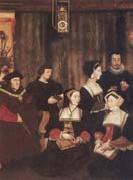 |
Rowland Lockey
|
|
English Baroque Era Painter, ca.1565-1616,was an English painter and goldsmith. The son of Leonard Lockey, a crossbow maker of the parish of St Bride's, Fleet Street, London, Lockey was apprenticed to Queen Elizabeth's miniaturist and goldsmith Nicholas Hilliard for eight years beginning Michaelmas 1581[1] and was made a freeman or master of the Worshipful Company of Goldsmiths by 1600. He worked mainly as a copyist of earlier portraits to make up sets of oil paintings for the fashionable long galleries of great houses, but signed or documented portrait miniatures on vellum and a signed title page engraving for the 1602 Bishops' Bible also survive. |
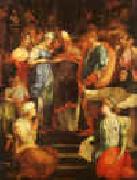 |
Rosso Fiorentino
|
|
Italian Mannerist Painter, ca.1495-1540
Born in Florence Italy with the red hair that gave him his nickname, Rosso first trained in the studio of Andrea del Sarto alongside his contemporary, Pontormo. In late 1523, Rosso moved to Rome, where he was exposed to the works of Michelangelo, Raphael, and other Renaissance artists, resulting in the realignment of his artistic style.
Fleeing Rome after the Sacking of 1527, Rosso eventually went to France where he secured a position at the court of Francis I in 1530, remaining there until his death. Together with Francesco Primaticcio, Rosso was one of the leading artists to work at the Chateau Fontainebleau as part of the "First School of Fontainebleau", spending much of his life there. Following his death in 1540 (which, according to an unsubstantiated claim by Vasari, was a suicide ), Francesco Primaticcio took charge of the artistic direction at Fontainebleau.
Rosso's reputation, along those of other stylized late Renaissance Florentines, was long out of favour in comparison to other more naturalistic and graceful contemporaries, but has revived considerably in recent decades. That his masterpiece is in a small city, away from the tourist track, was a factor in this, especially before the arrival of photography. His poses are certainly contorted, and his figures often appear haggard and thin, but his work has considerable power. |
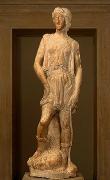 |
ROSSELLINO, Bernardo
|
|
Italian sculptor
Florentine school (b. 1409, Settignano, d. 1464, Firenze).Italian architect and sculptor. Influenced by Donatello, Filippo Brunelleschi, and Luca Della Robbia, he developed a moderately Classical style. His tomb for Leonardo Bruni (1444 C 50) in Santa Croce, Florence, was one of the greatest achievements of early Renaissance sculpture and inaugurated a new type of sepulchral monument. Its fine balance between sculpture and architecture, figure and decoration, made it the prototypical niche tomb of its time. He also designed the apse of St. Peter's Basilica and the cathedral and Piccolomini Palace in Pienza (1460 ?C 64). He presumably trained his brother Antonio (1427 ?C 79), who regularly assisted him.
|
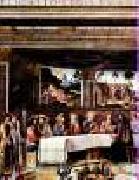 |
ROSSELLI, Cosimo
|
|
Italian Early Renaissance Painter, 1439-1507
Painter. He was documented in Neri di Bicci's workshop between May 1453 and October 1456; in 1459 he received his first known commission, for an altarpiece in Santa Tr?nita, Florence (untraced). It is thought that he subsequently worked with Benozzo Gozzoli, whose influence is evident in his early work, but Cosimo was receptive to the styles of almost all his more gifted contemporaries, including Alesso Baldovinetti (said by Baldinucci to have been his master), Andrea del Verrocchio and the Pollaiuolo brothers. Cosimo's first surviving works of importance are the frescoes in the style of Baldovinetti in the Salutati Chapel, Fiesole Cathedral, datable to between 1462 and 1466, but these are heavily restored. |
 |
Rosalba carriera
|
|
Italian Rococo Era Painter, 1675-1757
Italian pastellist and painter. She was a daughter of Andrea Carriera, who worked in the mainland podesteria of the Republic of Venice, and of Alba Foresti, an embroiderer. She had two sisters: Angela, who married the painter Giovanni Antonio Pellegrini, and Giovanna, who, like Rosalba herself, never married. Pier Caterino Zeno (see Campori, 1886) and other, anonymous sources recorded that she was a pupil of Giuseppe Diamantini; according to Mariette, she originally painted snuff-boxes and later became a pupil of Federico Bencovich. There are more precise records of her life and of some of her works from 1700 onwards |
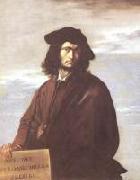 |
ROSA, Salvator
|
|
Italian Baroque Era Painter, 1615-1673
Italian painter, draughtsman, etcher, poet and actor. He was one of the most original artists and extravagant personalities of the 17th century. His most popular and influential works were his landscapes, the wild and mountainous beauty of which contrasted with the pastoral scenes of Claude Lorrain. Yet Rosa also painted macabre subjects, erudite philosophical allegories and grand historical themes; he was, moreover, the most significant satirical poet of the Italian 17th century, and there is a close relationship between his poetry and painting. His earliest biographers, Filippo Baldinucci and Giovanni Battista Passeri, both of whom knew him well, described at length his fiery temperament |
 |
Rosa Bonheur
|
|
1822-1899 Realism,French,French painter and sculptor. She received her training from her father, Raymond Bonheur (d 1849), an artist and ardent Saint-Simonian who encouraged her artistic career and independence. Precocious and talented, she began making copies in the Louvre at the age of 14 and first exhibited at the Salon in 1841. Her sympathetic portrayal of animals was influenced by prevailing trends in natural history (e.g. Etienne Geoffroy Saint-Hilaire) and her deep affinity for animals, especially horses. Bonheur's art, as part of the Realist current that emerged in the 1840s, was grounded in direct observation of nature and meticulous draughtsmanship. She kept a small menagerie, frequented slaughterhouses and dissected animals to gain anatomical knowledge. Although painting was her primary medium, she also sculpted, or modelled, studies of animals, several of which were exhibited at the Salons, including a bronze Study for a Bull and Sheep . |
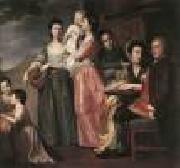 |
ROMNEY, George
|
|
English Painter, 1734-1802
The son of a cabinetmaker, George Romney was born in Dalton, Lancashire. He was apprenticed in 1755 to Christopher Steele, a provincial portrait painter, but was largely self-taught. Romney's ambition was to become a history painter. In 1762 he moved to London, where he studied the Duke of Richmond's collection of casts of antique sculpture and established himself as a portraitist. He went to Italy in 1773, and after his return in 1775 he became the favorite painter of high society. Morbidly sensitive and retiring, Romney kept aloof from the social world of his sitters and from the Royal Academy. By 1782 he was under the spell of Emma Hart, later Lady Hamilton and the mistress of Nelson, who sat for him as Circe, a Bacchante, Cassandra, the Pythian Priestess, Joan of Arc, St. Cecilia, Mary Magdalene, and other impersonations he suggested. In the 1780s he executed a number of Eton leaving portraits, which established him as the supreme interpreter of aristocratic adolescence in his age. For much of his life in London, Romney was under the wing of the poet William Hayley, who encouraged him in the choice of subjects from Milton and Shakespeare as well as the Bible and Greek tragedy. Romney's history paintings are today chiefly known from engravings, like the dramatic Tempest (1787-1790) commissioned for John Boydell's Shakespeare Gallery. A large number of drawings for these projects survive. Romney had married early in life an uneducated woman whom he did not bring to London but to whom he returned when his health finally gave way. Ill health and the facility with which he converted his early realistic style into a fashionable sketchlike formula for idealizing his sitters probably account for an unevenness of execution that has partially justified his critics. Unlike Joshua Reynolds, Romney did not enter into the character of his sitters, unless they possessed nervous traits like his own, for example, the moving portrait William Cowper. But he was psychologically involved with the generalized charms of youth, beauty, and breeding that he admired in his aristocratic sitters, and by combining a neoclassic purity of line with free but masterly brushwork he achieved a number of incomparable images which transcend the realism of portraiture. |
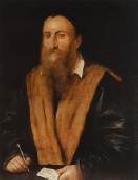 |
ROMANINO
|
|
Italian painter, Brescian school (b. ca. 1484, Brescia, d. ca. 1559,
Brescia). |
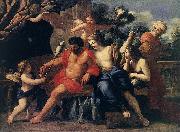 |
ROMANELLI, Giovanni Francesco
|
|
Italian painter, Roman school (b. 1610, Viterbo, d.1662, Viterbo).
Italian painter and draughtsman. He was the pupil first of Domenichino, then of Pietro da Cortona; his work also shows the influence of Bernini (in some of whose projects he became involved) and of Poussin. His calm and graceful synthesis of these extremes of austere Baroque classicism and High Baroque ebullience was prophetic of the effects of the Roman Late Baroque and of the generalized style of public painting that spread throughout Europe in the late 17th century and the early 18th. |
 |
Rogier van der Weyden
|
|
Rogier van der Weyden 1399/1400 - 1464 was the most important representative of Netherlandish painting or Northern Renaissance ... is, with Jan van Eyck, considered one of the greatest exponents of the school of Early Netherlandish painting. Rogier van der Weyden was born in Tournai as 'Rogier de le Pasture' (Roger of the Pasture) in 1399 or 1400. His parents were Henri de le Pasture and Agnes de Watr??los. The family had settled before in the city of Tournai where Rogiers father worked as a 'maître-coutelier' (knife manufacturer). In 1426 Rogier married Elisabeth, the daughter of the Brussels shoemaker Jan Goffaert and his wife Cathelyne van Stockem. Rogier and Elisabeth had four children: Cornelius, who became a Carthusian monk, was born in 1427, a daughter Margaretha in 1432. Before 21 October 1435 the family settled in Brussels where the two younger children were born: Pieter in 1437 and Jan the next year. From the second of March 1436 onwards held the title of 'painter to the town of Brussels' (stadsschilder) a very prestigious post because Brussels was at that time the most important residence of the splendid court of the Dukes of Burgundy. It was at the occasion of his move to the Dutch-speaking town of Brussels that Rogier began using the Dutch version of his name: 'Rogier van der Weyden'Little is known about Rogier's training as a painter. The archival sources from Tournai (completely destroyed during World War II, but luckily partly transcribed in the 19th and early 20th century) are somewhat confusing and have led to different interpretations by scholars. From a document it is known that the city council of Tournai offered wine in honour of a certain 'Maistre Rogier de le Pasture' on March the 17th 1427. However, on the 5th of March of the following year the records of the painters' guild show a certain 'Rogelet de le Pasture' entered the workshop of Robert Campin together with Jacques Daret. Only five years later, on the first of August 1432, Rogier de le Pasture obtains the title of 'Master' (Maistre) as a painter.[1] Many have doubted whether Campin's apprentice 'Rogelet' was the same as the master 'Rogier' that was offered the wine back in 1426. The fact that in 1426-1427 Rogier was a married man in his late twenties, and well over the normal age of apprenticeship has been used as an argument to consider 'Rogelet' as a younger painter with the same name. In the 1420's however the city of Tournai was in crisis and as a result the guilds were not functioning normally. The late apprenticeship of Rogier/Rogelet may have been a legal formality. Also Jacques Daret was then in his twenties and had been living and working in Campin's household for at least a decade. It is possible that Rogier obtained an academic title (Master) before he became a painter and that he was awarded the wine of honour on the occasion of his graduation. The sophisticated and 'learned' iconographical and compositional qualities of the paintings attributed to him are sometimes used as an argument in favour of this supposition. The social and intellectual status of Rogier in his later life surpassed that of a mere craftsman at that time. In general the close stylistical link between the documented works of Jacques Daret, and the paintings attributed to Robert Campin and Rogier van der Weyden is considered as the main argument to consider Rogier van der Weyden as a pupil of Robert Campin. The last mention of Rogier de la Pasture in the financial records of Tournai, on October 21, 1435, lists him as demeurrant ?? Brouxielles ('living in Brussels'). At the same time, the first mention of Rogier de Weyden is made as the official painter of Brussels. Therefore Rogier de la Pasture and Rogier Van der Weyden are thought to be one and the same painter. The post of city painter was created especially for Van der Weyden and was meant to lapse on his death. It was linked to a huge commission to paint four justice scenes for the 'Golden Chamber' of Brussels City Hall.[2] Different properties and investments are documented and witness his material prosperity. The portraits he painted of the Burgundian Dukes, their relatives and courtiers, demonstrate a close relationship with the elite of the Netherlands. The Miraflores Altarpiece was probably commissioned by King Juan II of Castile, since Juan II donated it to the monastery of Miraflores in 1445. |
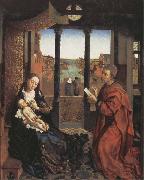 |
Roger Van Der Weyden
|
|
c.1399-1464
Rogier van der Weyden was the son of Henri de le Pasture, a cutler in Tournai, and Agn?s de Watreloz. His birthdate is estimated from the facts that he was stated to be 35 in April 1435 and 43 in September 1441. Before or in 1427 he married Elisabeth Goffaert (c. 1405-77), whose father was a prosperous shoemaker in Brussels. Rogier may have lived for a time in Brussels: his eldest child Cornelis (b 1427) was sometimes referred to as 'de Bruxella' but was not necessarily a native of Brussels. On 5 March 1427 'Rogelet de le Pasture, natif de Tournai' was apprenticed to the Tournai painter Robert Campin. This Rogelet duly completed his apprenticeship in 1431 and on 1 August 1432 became a master of the Tournai guild. Despite much debate, it would appear that Rogelet was Rogier van der Weyden, though it has also been argued that in 1427 Rogier was a married man well past the normal age of apprenticeship and that Rogelet must have been a second Tournai painter of the same name. JACQUES DARET, however, was in his twenties when in 1428 he was apprenticed to Campin, and other instances can be cited of married apprentices. The political situation at Tournai in 1427-8 was unusual, and the guild system was not functioning normally. |
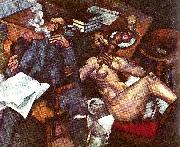 |
roger de la fresnaye
|
|
Roger de La Fresnaye (11 July 1885 - 27 November 1925) was a French cubist painter.
He was born in Le Mans where his father, an officer in the French army, was temporarily stationed. The La Fresnaye's were an aristocratic family whose ancestral home, the Château de La Fresnaye, is in Falaise. His education was classically based, and was followed from 1903 to 1904 by studies at the Acad??mie Julian in Paris, and from 1904 to 1908 at the Ecole des Beaux-Arts. From 1908 he studied at the Acad??mie Ranson under Maurice Denis and Paul S??rusier, whose joint influence is evident in early works such as Woman with Chrysanthemums, 1909. This demonstrates the dreamlike symbolist ambience and stylistic character of work by the Les Nabis group.
The Conquest of the Air, 1913. Museum of Modern Art, New York.From 1912 to 1914 he was a member of the Section d'Or group of artists, and his work demonstrates an individual response to cubism. He was influenced by Georges Braque and Pablo Picasso , but his work has a more decorative than structural feel and his prismatic colours reflect the influence of Robert Delaunay. He was a member of the Puteaux Group, an orphist offshoot of cubism led by Jacques Villon. His most famous work is The Conquest of the Air, 1913, and depicts a scene with himself and his brother outdoors with a balloon in the background.
La Fresnaye served in the French army in World War I and his health deteriorated rapidly after the war. He never recovered the physical energy to undertake sustained work. In the later paintings that he did create, he abandoned cubist spatial analysis for a more linear style. He died in Grasse in 1925. |
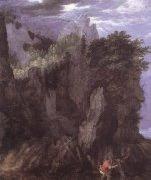 |
Roelant Savery
|
|
Flemish Northern Renaissance Painter, 1576-1639 . was a Flanders-born Dutch baroque painter of the Golden Age. Like so many other artists, Savery's Anabaptist family fled North from the Spanish occupied Southern Netherlands when Roelant was about 4 years old and settled in Haarlem around 1585. He was taught painting by his older brother Jacob Savery (c.1565-1603) and Hans Bol. After his schooling, Savery traveled to Prague around 1604, where he became court painter of the Emperors Rudolf II (1552-1612) and Mathias (1557-1619), who had made their court a center of mannerist art. Between 1606-1608 he traveled to Tyrol to study plants. Gillis d'Hondecoeter became his pupil.[3] Before 1616 Savery moved back to Amsterdam, and lived in the Sint Antoniesbreestraat. In 1618 he settled in Utrecht, where he joined the artist's guild a year later. His nephew Hans would become his most important assistant. In 1621 Savery bought a large house on the Boterstraat in Utrecht. The house had a large garden with flowers and plants, where a number of fellow painters, like Adam Willaerts were frequent visitors. Savery had kept his house in Amsterdam, and had one child baptized in Nieuwe Kerk (Amsterdam).[4] Savery was friends with still life painters like Balthasar van der Ast and Ambrosius Bosschaert. In the 1620s he was one of the most successful painters in Utrecht, but later his life got troubled, perhaps because of heavy drinking. Though he would have pupils until the late 1630s |
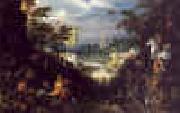 |
Roelandt Savery
|
|
1576-1639
Roelandt Savery Gallery
Like so many other artists, Savery's Anabaptist family fled North from the Spanish occupied Southern Netherlands when Roelant was about 4 years old and settled in Haarlem around 1585. He was taught painting by his older brother Jacob Savery (c.1565-1603) and Hans Bol.
After his schooling, Savery traveled to Prague around 1604, where he became court painter of the Emperors Rudolf II (1552-1612) and Mathias (1557-1619), who had made their court a center of mannerist art. Between 1606-1608 he traveled to Tyrol to study plants. Gillis d'Hondecoeter became his pupil.
Before 1616 Savery moved back to Amsterdam, and lived in the Sint Antoniesbreestraat. In 1618 he settled in Utrecht, where he joined the artist's guild a year later. His nephew Hans would become his most important assistant.
In 1621 Savery bought a large house on the Boterstraat in Utrecht. The house had a large garden with flowers and plants, where a number of fellow painters, like Adam Willaerts were frequent visitors. Savery had kept his house in Amsterdam, and had one child baptized in Nieuwe Kerk (Amsterdam).
Savery was friends with still life painters like Balthasar van der Ast and Ambrosius Bosschaert. In the 1620s he was one of the most successful painters in Utrecht, but later his life got troubled, perhaps because of heavy drinking. Though he would have pupils until the late 1630s, amongst which Allaert van Everdingen and Roelant Roghman, he went bankrupt in 1638 and died half a year later. |
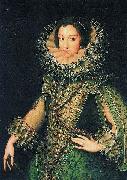 |
Rodrigo de Villandrando
|
|
Rodrigo de Villandrando (1588 - December 1623) was a court painter during the reign of Philip III of Spain. He worked in the tradition of Alonso Senchez Coello and Juan Pantoja de la Cruz. His death opened the road to court for the young painter Diego Velezquez from Sevilla. |
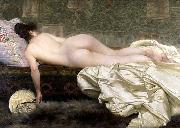 |
Rodolfo Amoedo
|
|
(born in Salvador, Bahia on December 11, 1857; died in Rio de Janeiro on May 31, 1941) was a Brazilian history painter. He began his career as an artist in 1873 as a student of Victor Meirelles. In 1878 he won the first prize at the Brazilian Academy, which allowed him to travel to Paris, where he lived from 1879 to 1887 studying at the École des Beaux Arts. He was a pupil of Alexandre Cabanel and also worked with Paul-Jacques-Aime Baudry. He was a professor and later director of the Brazilian Academy, renamed School of Fine Arts ou Escola Nacional de Belas Artes at the fall of the Brazilian Empire. His students include Eliseu Visconti. He died forgotten and so poor his friends had to help the widow pay for his funeral. His paintings still hang at the National Museum Museu Nacional de Belas Artes in Rio de Janeiro. |
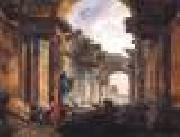 |
ROBERT, Hubert
|
|
French Rococo Era Painter, 1733-1808
French painter, draughtsman, etcher and landscape designer. He was one of the most prolific and engaging landscape painters in 18th-century France. He specialized in architectural scenes in which topographical elements derived from the buildings and monuments of ancient and modern Italy and of France are combined in often fantastic settings or fictitious juxtapositions. The fluid touch and rich impasto employed in his paintings |
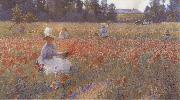 |
Robert William Vonnoh
|
|
American portrait and landscape painter, 1858-1933
was an American Impressionist painter known for his portraits and landscapes. |
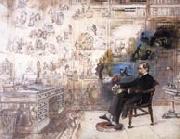 |
Robert William Buss
|
|
British painter and etcher , 1804-1875
was a Victorian artist, etcher and illustrator perhaps best known for his painting Dickens' Dream. Born in Bull and Mouth Street, Aldersgate in London in 1804, Buss served an apprenticeship with his father, a master engraver and enameller, and then studied painting under George Clint, a miniaturist, watercolour and portrait painter, and mezzotint engraver. At the start of his career Buss specialized in painting theatrical portraits, with many of the leading actors of the day sitting to him, including William Charles Macready, John Pritt Harley, and John Baldwin Buckstone. Later Buss painted historical and humorous subjects. He exhibited a total of 112 pictures between 1826 and 1859, twenty-five at the Royal Academy, twenty at the British Institution, |
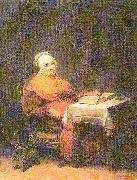 |
Robert Wilhelm Ekman
|
|
(August 13, 1808 - February 19, 1873), aka R. W. Ekman, was a significant teacher and painter of the Finnish romantic portraits and early national romanticism.
Robert Ekman was born in Uusikaupunki, Finland to an upper class family. His father was Karl Kristoffer Ekman, a medical doctor and a mayor. Mother was Sara Elisabet (maiden name Gadolin). Robert Ekman's both parents died when he was about 10 years old. They left behind five orphans who were placed in foster homes. Schooling was incomplete and there was no chance of academic education.
Robert Ekman first studied in Finland under the guidance of Gustaf Wilhelm Finnberg, but in 1824, with his brother Fredrubjm begun studies in Kungliga Akademien för de Fria Konsterna (The royal academy for free arts) in Stockholm. Already as a student Ekman specialized in portraying the life of the common people, instead of Classicism of the academic arts. Ekman graduated in 1836, and was granted a generous traveling scholarship for excelling in his studies. That supported him working in Holland, France and Italy between years 1837-1844. As the scholarship was not plausible otherwise, Ekman took the Swedish citizenship.
|
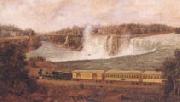 |
Robert Whale
|
|
Born in Alternun, England in 1805. Died in Brantford, Ontario in 1887 |
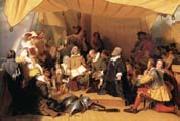 |
Robert Walter Weir
|
|
Jun 18.1803-May 1.1889, Painter and teacher. By his own account he was self-taught, with the exception of a few lessons from an unknown heraldic painter named Robert Cooke. However, after exhibiting a few works that were praised by the local press, he was sent to Italy by a group of New York and Philadelphia businessmen for further studies. There he trained with Florentine history painter Pietro Benvenuti. After three years in Europe (1824-7), he returned to New York, where he quickly became a mainstay of the artistic community. In 1831 he was elected to membership in the National Academy of Design in New York, and three years later he was made instructor of drawing at the US Military Academy in West Point, New York, a post he held for the next 42 years. |
|

